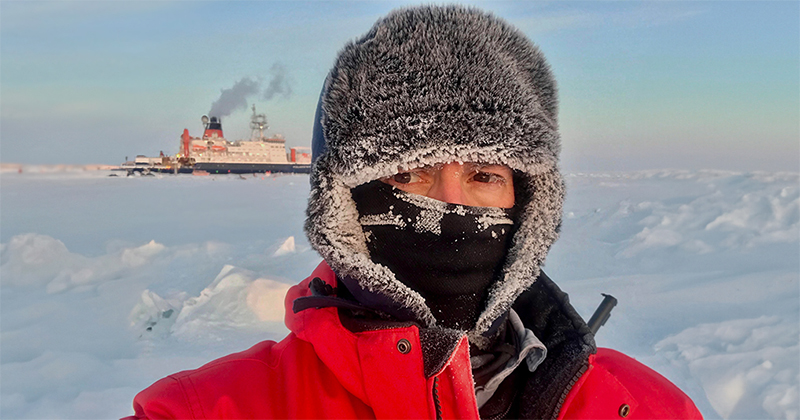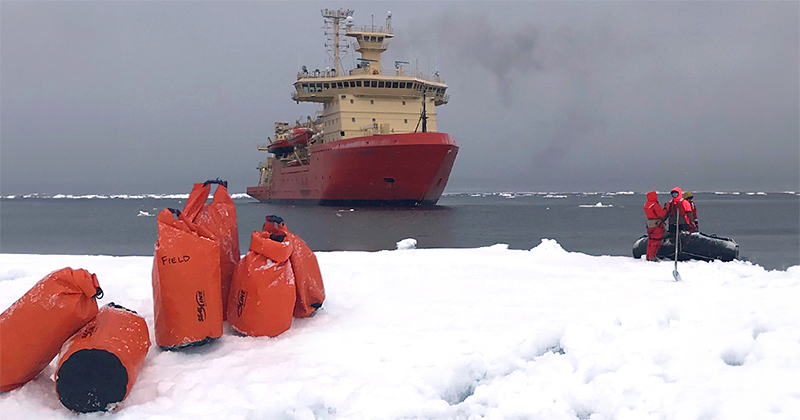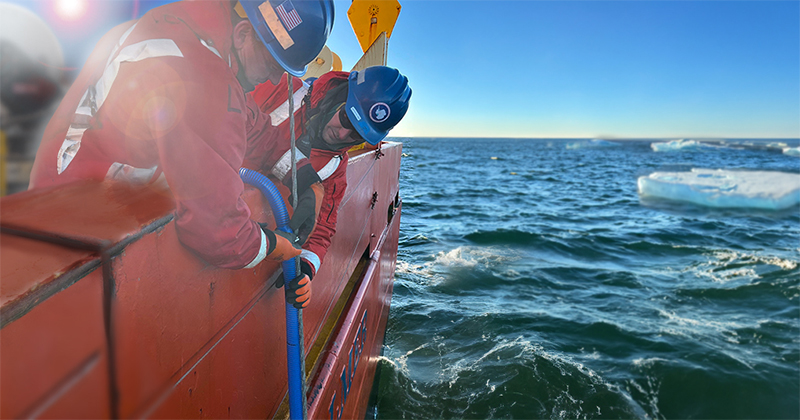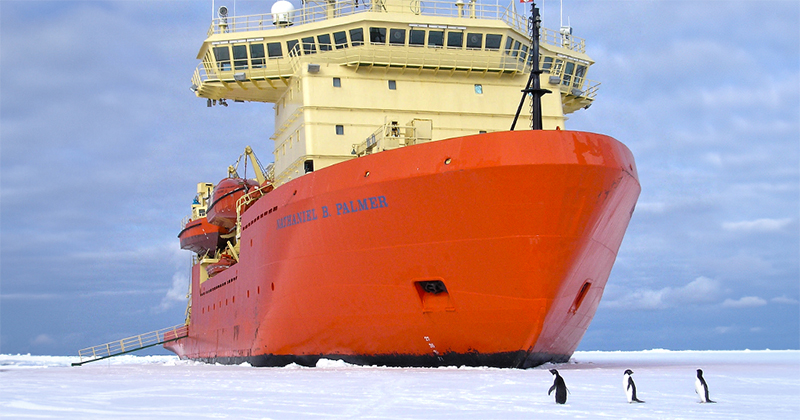


Tracing elements in the Antarctic coastal seas
Photos courtesy of Chris Marsay January 23, 2024
UD’s Chris Marsay heads to the Southern Ocean as part of latest GEOTRACES research cruise
Chris Marsay has been to the Southern Ocean three times already in his career, but when he gets the chance to conduct research in such a remote part of the world, he jumps at the opportunity. Maybe it’s the giant icebergs floating past the ship, or maybe it’s sharing a portion of the sea with penguins, whales and seals. But Marsay loves conducting research in the Southern Ocean because it’s unlike any other place that he has ever worked.
Marsay, associate scientist in the School of Marine Science and Policy in the University of Delaware’s College of Earth, Ocean and Environment, is taking part in the latest research cruise as a part of the GEOTRACES International Program. He headed to the Amundsen Sea Sector of the Southern Ocean on Nov. 23, 2023, and will work through Jan. 28, 2024.
According to the GEOTRACES website, the aim of the program is to improve the understanding of biogeochemical cycles and large-scale distribution of trace elements and their isotopes in the marine environment. Scientists from approximately 35 countries have been involved in the program, which is designed to study all the major ocean basins.
Participants traveled to the Southern Ocean on the Research Vessel Nathaniel B. Palmer, a 94-meter research ship with icebreaking capability used by the U.S. Antarctic Program that can operate safely year-round in Antarctic waters that are often stormy or covered with sea ice.

During a six-week period spent in the Antarctic coastal seas, the researchers will run a series of transects to collect samples and map the distribution of different elements in the water column to assess sources such as glacial inputs and release from sediments, and how ocean circulation and biological processes influence different elements in the ocean.
For his aspect of the study, Marsay will look at atmospheric deposition, or the input of materials from the atmosphere that typically happens when particles settle from the atmosphere to the ocean surface or are carried there by rain or snow.
“With this project, my main duties are going to be collecting aerosol samples,” Marsay said. “To do that, we’ll have a series of samplers set up on one of the upper decks of the ship. These consist of a motor, which pulls air through a set of filters, trapping any particles, and then we bring the filters back to the lab and do various analyses on them to determine the concentrations of the different elements.”
Marsay said it is important to understand atmospheric deposition because in remote ocean regions, atmospheric deposition plays a substantial role in the introduction of material to the ocean.
Understanding the biogeochemical cycles and the large-scale distribution of trace elements — elements that are present in the marine environment in very low concentrations — is important because while they may be present in low concentrations, they play critical roles in the ocean.

“Some of them, such as iron, act as nutrients and are essential for phytoplankton to grow, so they can play a role in regulating ocean productivity and the drawdown of carbon dioxide from the atmosphere,” Marsay said. “On the other hand, some of them act as pollutants or contaminants. For example, mercury and lead have significant anthropogenic sources relative to their natural ocean inputs and can enter the food chain despite not having a confirmed biological role. Other elements are useful because we can use their concentrations to pick out information about the delivery of material to the ocean from specific sources.”
The area where the expedition is heading hasn’t had many such measurements taken because it is such a difficult environment in which to work. Marsay said he expects the aerosol concentrations of elements that they’re interested in to be particularly low because it’s an environment that is isolated from major sources, but whatever numbers they find will play an important role in atmospheric input models moving forward.
“There are models that estimate the input of different elements based on atmospheric transport patterns and the distribution of major sources, and the models do provide an estimate of the iron input in that region, for example,” Marsay said. “It may be that our measurements suggest that the models are wrong, maybe they underestimate the rate of input, and if that’s the case, it’s very interesting. It’s not necessarily a problem, but it will mean that those models can be adjusted to more accurately represent the data and better predict potential future changes.”
Marsay added that the project he will be working on is research that started when he was a postdoctoral researcher at the University of Georgia (UGA), where he was awarded funding for the project from the National Science Foundation along with Clifton Buck, associate professor at UGA.
“I’ve been working with aerosols and atmospheric deposition for about the last eight years, and I’ve been involved in other GEOTRACES transects in the Pacific Ocean and the Arctic Ocean,” Marsay said. “Despite the fact that these trace elements are present in very low concentrations, they are important and of interest. The aerosol samples that we collect are a mixture of natural dust that gets transported from arid regions of the land, and it also includes pollutants released by industry and soot from forest fires. It’s a big mixture of materials and the different sources have varying degrees of importance for different elements so I’m excited to get down there and see what we find.”

Contact Us
Have a UDaily story idea?
Contact us at ocm@udel.edu
Members of the press
Contact us at mediarelations@udel.edu or visit the Media Relations website

